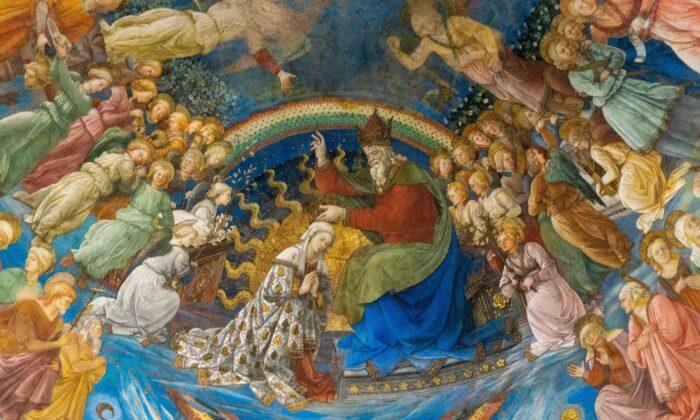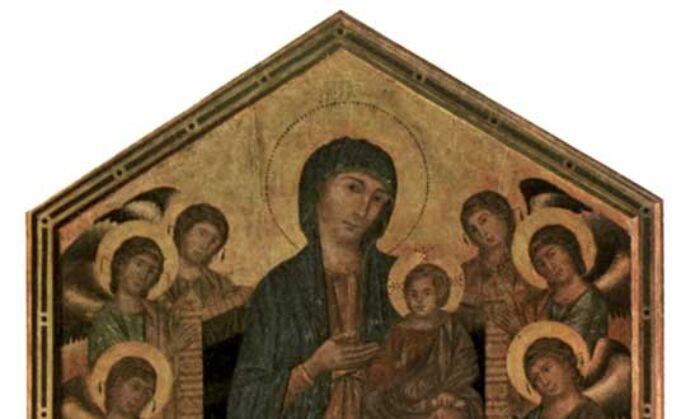Fra Filippo di Tommaso Lippi, a Carmelite, was born in Florence in a street called Ardiglione, below the Canto alla Cuculia and behind the Convent of the Carmelites. By the death of his father Tommaso he was left a poor little orphan at the age of two, with no one to take care of him, for his mother had also died not long after giving him birth. He was left, therefore, in the charge of one Mona Lapaccia, his aunt, sister of his father, who brought him up with very great inconvenience to herself; and when he was eight years of age and she could no longer support him, she made him a friar in the aforesaid Convent of the Carmine. Living there, in proportion as he showed himself dexterous and ingenious in the use of his hands, so was he dull and incapable of making any progress in the learning of letters, so that he would never apply his intelligence to them or regard them as anything save his enemies. This boy, who was called by his secular name of Filippo, was kept with others in the noviciate under the discipline of the schoolmaster, in order to see what he could do; but in place of studying he would never do anything save deface his own books and those of the others with caricatures. Whereupon the Prior resolved to give him every opportunity and convenience for learning to paint. There was then in the Carmine a chapel that had been newly painted by Masaccio, which, being very beautiful, pleased Fra Filippo so greatly that he would haunt it every day for his recreation; and continually practising there in company with many young men, who were ever drawing in it, he surpassed the others by a great measure in dexterity and knowledge, insomuch that it was held certain that in time he would do something marvellous. Nay, not merely in his maturity,
but even in his early childhood, he executed so many works worthy of praise that it was a miracle. It was no long time before he wrought in terra-verde in the cloister, close to the Consecration painted by Masaccio, a Pope confirming the Rule of the Carmelites; and he painted pictures in fresco on various walls in many parts of the church, particularly a S. John the Baptist with some scenes from his life. And thus, making progress every day, he had learnt the manner of Masaccio very well, so that he made his works so similar to those of the other that many said that the spirit of Masaccio had entered into the body of Fra Filippo. On a pilaster in the church, close to the organ, he made a figure of S. Marziale which brought him infinite fame, for it could bear comparison with the works that Masaccio had painted. Wherefore, hearing himself so greatly praised by the voices of all, at the age of seventeen he boldly threw off his monastic habit.
Now, chancing to be in the March of Ancona, he was disporting himself one day with some of his friends in a little boat on the sea, when they were all captured together by the Moorish galleys that were scouring those parts, and taken to Barbary, where each of them was put in chains and held as a slave; and thus he remained in great misery for eighteen months. But one day, seeing that he was thrown much into contact with his master, there came to him the opportunity and the whim to make a portrait of him; whereupon, taking a piece of dead coal from the fire, with this he portrayed him at full length on a white wall in his Moorish costume. When this was reported by the other slaves to the master (for it appeared a miracle to them all, since drawing and painting were not known in these parts), it brought about his liberation from the chains in which he had been held for so long. Truly glorious was it for this art to have caused one to whom the power of condemnation and punishment was granted by law, to do the very opposite—nay, in place of inflicting pains and death, to consent to show friendliness and grant liberty! After having wrought some works in colour for his master, he was brought safely to Naples, where he painted for King Alfonso, then Duke of Calabria, a panel in distemper for the Chapel of the Castle, where the guard-room now is.
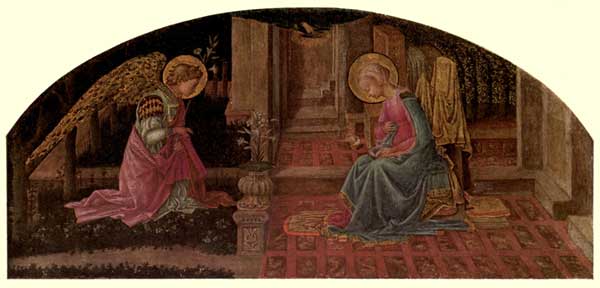
Fra Filippo Lippi: The Annunciation
(London: National Gallery, 666. Panel)
After this there came upon him a desire to return to Florence, where he remained for some months. There he wrought a very beautiful panel for the high-altar of the Nuns of S. Ambrogio, which made him very dear to Cosimo de' Medici, who became very much his friend for this reason. He also painted a panel for the Chapter-house of S. Croce, and another that was placed in the chapel of the house of the Medici, on which he painted the Nativity of Christ. For the wife of the said Cosimo, likewise, he painted a panel with the same Nativity of Christ and with S. John the Baptist, which was to be placed in the Hermitage of Camaldoli, in one of the hermits’ cells, dedicated to S. John the Baptist, which she had caused to be built in proof of her devotion. And he painted some little scenes that were sent by Cosimo as a gift to Pope Eugenius IV, the Venetian; wherefore Fra Filippo acquired great favour with that Pope by reason of this work.
It is said that he was so amorous, that, if he saw any women who pleased him, and if they were to be won, he would give all his possessions to win them; and if he could in no way do this, he would paint their portraits and cool the flame of his love by reasoning with himself. So much a slave was he to this appetite, that when he was in this humour he gave little or no attention to the works that he had undertaken; wherefore on one occasion Cosimo de' Medici, having commissioned him to paint a picture, shut him up in his own house, in order that he might not go out and waste his time; but after staying there for two whole days, being driven forth by his amorous—nay, beastly—passion, one night he cut some ropes out of his bed-sheets with a pair of scissors and let himself down from a window, and then abandoned himself for many days to his pleasures. Thereupon, since he could not be found, Cosimo sent out to look for him, and finally brought him back to his labour; and thenceforward Cosimo gave him liberty to go out when he pleased, repenting greatly that he had previously shut him up, when he thought of his madness and of the danger that he might run. For this reason he strove to keep a hold on him for the future by kindnesses; and so he was served by Filippo with greater readiness, and was wont to say that the virtues of rare minds were celestial beings, and not slavish hacks.
For the Church of S. Maria Primerana, on the Piazza of Fiesole, he painted a panel containing the Annunciation of Our Lady by the Angel, which shows very great diligence, and there is such beauty in the figure of the Angel that it appears truly a celestial thing. For the Nuns of the Murate he painted two panels: one, containing an Annunciation, is placed on the high-altar; and the other is on an altar in the same church, and contains stories of S. Benedict and S. Bernard. In the Palace of the Signoria he painted an Annunciation on a panel, which is over a door; and over another door in the said Palace he also painted a S. Bernard. For the Sacristy of S. Spirito in Florence he executed a panel with the Madonna surrounded by angels, and with saints on either side—a rare work, which has ever been held in the greatest veneration by the masters of these our arts. In the Chapel of the Wardens of Works in S. Lorenzo he wrought a panel with another Annunciation; with one for the Della Stufa Chapel, which he did not finish. For a chapel in S. Apostolo, in the same city, he painted a panel with some figures round a Madonna. In Arezzo, by order of Messer Carlo Marsuppini, he painted the panel of the Chapel of S. Bernardo for the Monks of Monte Oliveto, depicting therein the Coronation of Our Lady, surrounded by many saints; which picture has remained so fresh, that it appears to have been made by the hand of Fra Filippo at the present day. It was then that he was told by the aforesaid Messer Carlo to give attention to the painting of the hands, seeing that his works were much criticized in this respect; wherefore from that day onwards, in painting hands, Fra Filippo covered the greater part of them with draperies or with some other contrivance, in order to avoid the aforesaid criticism. In this work he portrayed the said Messer Carlo from the life.
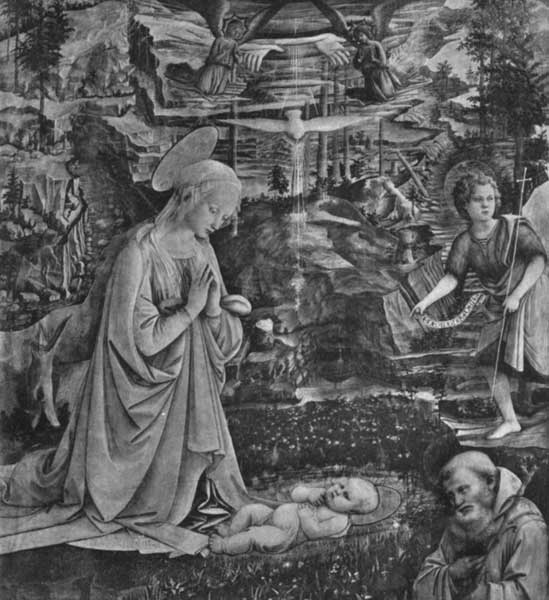
The Virgin Adoring
(After the panel by Fra Filippo Lippi. Florence: Accademia, 79)
Anderson
For the Nuns of Annalena in Florence he painted a Manger on a panel; and some of his pictures are still to be seen in Padua. He sent two little scenes with small figures, painted by his hand, to Cardinal Barbo in Rome; these were very excellently wrought, and executed with great diligence. Truly marvellous was the grace with which he painted, and very perfect the harmony that he gave to his works, for which he has been ever esteemed by craftsmen and honoured by our modern masters
with consummate praise; nay, so long as the voracity of time allows his many excellent labours to live, he will be held in veneration by every age. In Prato, near Florence, where he had some relatives, he stayed for many months, executing many works throughout that whole district in company with Fra Diamante, a friar of the Carmine, who had been his comrade in the noviciate. After this, having been commissioned by the Nuns of S. Margherita to paint the panel of their high-altar, he was working at this when there came before his eyes a daughter of Francesco Buti, a citizen of Florence, who was living there as a ward or as a novice. Having set eyes on Lucrezia (for this was the name of the girl), who was very beautiful and graceful, Fra Filippo contrived to persuade the nuns to allow him to make a portrait of her for a figure of Our Lady in the work that he was doing for them. With this opportunity he became even more enamoured of her, and then wrought upon her so mightily, what with one thing and another, that he stole her away from the nuns and took her off on the very day when she was going to see the Girdle of Our Lady, an honoured relic of that township, being exposed to view. Whereupon the nuns were greatly disgraced by such an event, and her father, Francesco, who never smiled again, made every effort to recover her; but she, either through fear or for some other reason, refused to come back—nay, she insisted on staying with Filippo, to whom she bore a male child, who was also called Filippo, and who became, like his father, a very excellent and famous painter.
In S. Domenico, in the aforesaid Prato, there are two of his panels; and in the tramezzo
[12] of the Church of S. Francesco there is a Madonna, in the removing of which from the place where it was at first, it was cut out from the wall on which it was painted, in order not to spoil it, and bound round with wood, and then transported to that wall of the church where it is still to be seen to-day. In a courtyard of the Ceppo of Francesco di Marco, over a well, there is a little panel by the hand of the same man, containing the portrait of the said Francesco di Marco, the creator and founder of that holy place. In the Pieve of the said township, on a little panel over the side-door as one ascends the steps, he painted the
Death of S. Bernard, by the touch of whose bier many cripples are being restored to health. In this picture are friars bewailing the death of their master, and it is a marvellous thing to see the beautiful expression of the sadness of lamentation in the heads, counterfeited with great art and resemblance to nature. Here there are draperies in the form of friars’ gowns with most beautiful folds, which deserve infinite praise for their good design, colouring, and composition; not to mention the grace and proportion that are seen in the said work, which was executed with the greatest delicacy by the hand of Fra Filippo. The Wardens of Works for the said Pieve, in order to have some memorial of him, commissioned him to paint the Chapel of the High-Altar in that place; and he gave great proof of his worth in that work, which, besides its general excellence and masterliness, contains most admirable draperies and heads. He made the figures therein larger than life, thus introducing to our modern craftsmen the method of giving grandeur to the manner of our own day. There are certain figures with garments little used in those times, whereby he began to incite the minds of men to depart from that simplicity which should be called rather old-fashioned than ancient. In the same work are the stories of S. Stephen (the titular Saint of the said Pieve), distributed over the wall on the right hand—namely, the Disputation, the Stoning, and the Death of that Protomartyr, in whose face, as he disputes with the Jews, Filippo depicted so much zeal and so much fervour, that it is a difficult thing to imagine it, and much more to express it; and in the faces and the various attitudes of the Jews he revealed their hatred, disdain, and anger at seeing themselves overcome by him. Even more clearly did he make manifest the brutality and rage of those who are slaying him with stones, which they have grasped, some large, some small, with a horrible gnashing of teeth, and with gestures wholly cruel and enraged. None the less, amid so terrible an onslaught, S. Stephen, raising his countenance with great calmness to Heaven, is seen making supplication to the Eternal Father with the warmest love and fervour for the very men who are slaying him. All these conceptions are truly very beautiful, and serve to show to others how great is the value of invention and of knowing how to express
emotions in pictures; and this he remembered so well, that in those who are burying S. Stephen he made gestures so dolorous, and some faces so afflicted and broken with weeping, that it is scarcely possible to look at them without being moved. On the other side he painted the Birth of S. John the Baptist, the Preaching, the Baptism, the Feast of Herod, and the Beheading of the Saint. Here, in his countenance as he is preaching, there is seen the Divine Spirit; with various emotions in the multitude that is listening, joy and sorrow both in the women and in the men, who are all hanging intently on the teaching of S. John. In the Baptism are seen beauty and goodness; and, in the Feast of Herod, the majesty of the banquet, the dexterity of Herodias, the astonishment of the company, and their immeasurable grief when the severed head is presented in the charger. Round the banqueting-table are seen innumerable figures with very beautiful attitudes, and with good execution both in the draperies and in the expressions of the faces. Among these, with a mirror, he portrayed himself dressed in the black habit of a prelate; and he made a portrait of his disciple Fra Diamante among those who are bewailing S. Stephen. This work is in truth the most excellent of all his paintings, both for the reasons mentioned above, and because he made the figures somewhat larger than life, which encouraged those who came after him to give grandeur to their manner. So greatly was he esteemed for his excellent gifts, that many circumstances in his life that were worthy of blame were passed over in consideration of the eminence of his great talents. In this work he portrayed Messer Carlo, the natural son of Cosimo de' Medici, who was then Provost of that church, which received great benefactions from him and from his house.
In the year 1463, when he had finished this work, he painted a panel in distemper, containing a very beautiful Annunciation, for the Church of S. Jacopo in Pistoia, by order of Messer Jacopo Bellucci, of whom he made therein a most vivid portrait from the life. In the house of Pulidoro Bracciolini there is a picture by his hand of the Birth of Our Lady; and in the Hall of the Tribunal of Eight in Florence he painted in distemper a Madonna with the Child in her arms, on a lunette. In the house of Lodovico Capponi there is another picture with a very beautiful
Madonna; and in the hands of Bernardo Vecchietti, a gentleman of Florence and a man of a culture and excellence beyond my power of expression, there is a little picture by the hand of the same man, containing a very beautiful S. Augustine engaged in his studies. Even better is a S. Jerome in Penitence, of the same size, in the guardaroba of Duke Cosimo; for if Fra Filippo was a rare master in all his pictures, he surpassed himself in the small ones, to which he gave such grace and beauty that nothing could be better, as may be seen in the predelle of all the panels that he painted. In short, he was such that none surpassed him in his own times, and few in our own; and Michelagnolo has not only always extolled him, but has imitated him in many things.
For the Church of S. Domenico Vecchio in Perugia, also, he painted a panel that was afterwards placed on the high-altar, containing a Madonna, S. Peter, S. Paul, S. Louis, and S. Anthony the Abbot. Messer Alessandro degli Alessandri, a Chevalier of that day and a friend of Filippo, caused him to paint a panel for the church of his villa at Vincigliata on the hill of Fiesole, containing a S. Laurence and other Saints, among whom he portrayed Alessandro and two sons of his.
Fra Filippo was much the friend of gay spirits, and he ever lived a joyous life. He taught the art of painting to Fra Diamante, who executed many pictures in the Carmine at Prato; and he did himself great credit by the close imitation of his master’s manner, for he attained to the greatest perfection. Sandro Botticelli, Pesello, and Jacopo del Sellaio of Florence worked with Fra Filippo in their youth (the last-named painted two panels in S. Friano, and one wrought in distemper in the Carmine), with a great number of other masters, to whom he ever taught the art with great friendliness. He lived honourably by his labours, spending extraordinary sums on the pleasures of love, in which he continued to take delight right up to the end of his life. He was requested by the Commune of Spoleto, through the mediation of Cosimo de' Medici, to paint the chapel in their principal church (dedicated to Our Lady), which he brought very nearly to completion, working in company with Fra Diamante, when death intervened to prevent him from finishing
it. Some say, indeed, that in consequence of his great inclination for his blissful amours some relations of the lady that he loved had him poisoned.
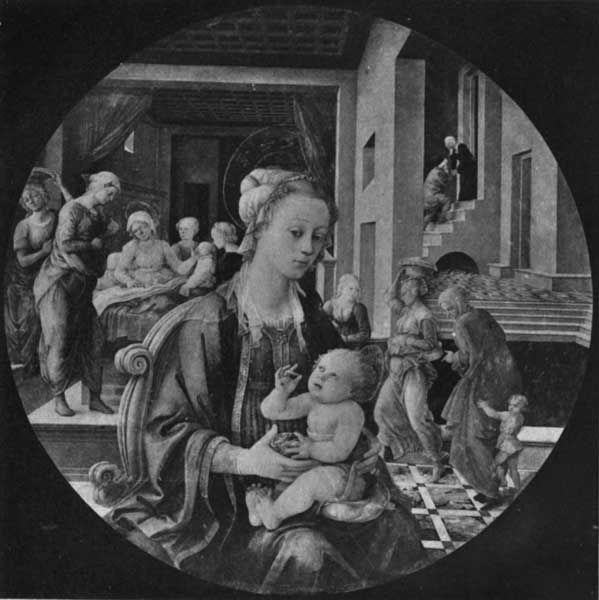
Madonna and Child
(After the panel (tondo) by Fra Filippo Lippi. Florence: Pitti, 343)
Anderson
Fra Filippo finished the course of his life in 1438, at the age of fifty-seven, and left a will entrusting to Fra Diamante his son Filippo, a little boy of ten years of age, who learnt the art of painting from his guardian. Fra Diamante returned with him to Florence, carrying away three hundred ducats, which remained to be received from the Commune of Spoleto for the work done; with these he bought some property for himself, giving but a little share to the boy. Filippo was placed with Sandro Botticelli, who was then held a very good master; and the old man was buried in a tomb of red and white marble, which the people of Spoleto caused to be erected in the church that he had been painting.
His death grieved many friends, particularly Cosimo de' Medici, as well as Pope Eugenius, who offered in his life-time to give him a dispensation, so that he might make Lucrezia, the daughter of Francesco Buti, his legitimate wife; but this he refused to do, wishing to have complete liberty for himself and his appetites.
While Sixtus IV was alive, Lorenzo de' Medici became ambassador to the Florentines, and made the journey to Spoleto, in order to demand from that community the body of Fra Filippo, to the end that it might be laid in S. Maria del Fiore in Florence; but their answer to him was that they were lacking in ornaments, and above all in distinguished men, for which reason they demanded Filippo from him as a favour in order to honour themselves, adding that since there was a vast number of famous men in Florence, nay, almost a superfluity, he should consent to do without this one; and more than this he could not obtain. It is true, indeed, that afterwards, having determined to do honour to him in the best way that he could, he sent his son Filippino to Rome to paint a chapel for the Cardinal of Naples; and Filippino, passing through Spoleto, caused a tomb of marble to be erected for him at the commission of Lorenzo, beneath the organ and over the sacristy, on which he spent one hundred ducats of gold, which were paid by Nofri Tornabuoni, master of the bank of the Medici; and Lorenzo also caused Messer
Angelo Poliziano to write the following epigram, which is carved on the said tomb in antique lettering:
CONDITUS HIC EGO SUM PICTURÆ FAMA PHILIPPUS;
NULLI IGNOTA MEÆ EST GRATIA MIRA MANUS.
ARTIFICES POTUI DIGITIS ANIMARE COLORES,
SPERATAQUE ANIMOS FALLERE VOCE DIU.
IPSA MEIS STUPUIT NATURA EXPRESSA FIGURIS,
MEQUE SUIS FASSA EST ARTIBUS ESSE PAREM.
MARMOREO TUMULO MEDICES LAURENTIUS HIC ME
CONDIDIT; ANTE HUMILI PULVERE TECTUS ERAM.
Fra Filippo was a very good draughtsman, as may be seen in our book of drawings by the most famous painters, particularly in some wherein the panel of S. Spirito is drawn, with others showing the chapel in Prato.




